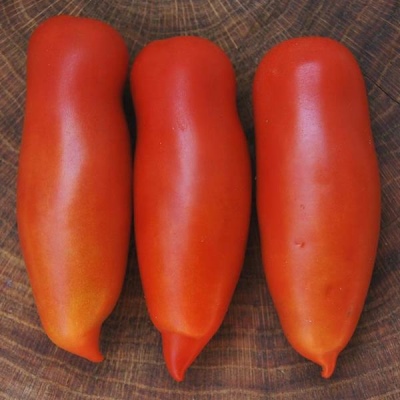
- Authors: Gavrish S.F., Morev V.V., Amcheslavskaya E.V., Volok O.A., Gavrish F.S.
- Year of approval: 2004
- Category: grade
- Growth type: indeterminate
- Appointment: fresh consumption, for whole fruit preservation
- Ripening period: mid-season
- Ripening time, days: 112-119
- Growing conditions: for film greenhouses, for greenhouses
- Bush size: tall
- Bush height, cm: more than 200
When choosing a tomato for planting in the country, gardeners take into account various factors. Someone is interested in color, someone wants a certain size, and there are those who make a choice in favor of varieties with an unusual shape. The Khokhloma variety belongs to such tomatoes.
Breeding history
The authors of the Khokhloma variety were Russian breeders, known for their other works. They are S. F. Gavrish, V. V. Morev, E. V. Amcheslavskaya, O. A. Volok, F. S. Gavrish. The originators were the Research Institute of Vegetable Crops Breeding and the “Gavrish Breeding Firm”. In 2004, the Khokhloma variety was included in the state register in the Russian Federation and was recommended for growing in temporary film shelters, in unheated film greenhouses in garden plots, as well as in small farms.
Description of the variety
The Khokhloma variety is vigorous, belonging to the indeterminate, which means that it grows up to 2 m and more. Leaves are medium in size, dark green. The first of the simple inflorescences is formed over 8 or 9 leaves, then the ovaries go every 3 leaves. From 12 to 15 fruits are laid in the brush, which are firmly attached, do not crumble. Tomatoes removed from the bush are stored for up to 2-3 weeks thanks to their strong and dense skin. They are also transported very well, practically without loss of taste and presentation.
The main qualities of the fruit
The berries of the variety in question are cylindrical. According to some descriptions, they can also be banana-shaped. As for the color, the unripe fruit is always light green, while the ripe fruit has a traditional and bright red color. Nests inside the fetus 2-3. Tomatoes weigh on average 108-127 grams. The length of an elongated tomato is 10-12 cm.
Taste characteristics
Khokhloma tomatoes have an excellent taste and are characterized by a large amount of vitamins in their composition. Ideal for whole fruit canning. Some disadvantages are the excessive density of the vegetable, not too pronounced juiciness and thick skin. For example, it will be difficult to prepare juice. However, many people, on the contrary, like the crispness and density of ripe tomatoes.
Ripening and fruiting
Khokhloma tomatoes ripen 112-119 days after germination. They are referred to the mid-season group. Harvested in the second month of summer.
Yield
The yield of marketable fruits is almost always at the level of 8.5-9.9 kg / sq. m. From one bush, you can remove from 4.5 to 5.5 kg of tomatoes.
The timing of planting seedlings and planting in the ground
It is possible to grow tomatoes of the Khokhloma variety both in open beds and in greenhouse conditions. It is worth starting planting seed material for seedlings in March. Before sowing, the seeds are treated with a solution of potassium permanganate, then washed in clean water. Dive at stage 1 of this leaf. The transfer of seedlings ready for planting is carried out in the following terms: to the greenhouse - in April, to open ground - in May.

Growing tomato seedlings is an extremely important process, because it largely depends on whether the gardener will be able to harvest at all. All aspects must be taken into account, from seedbed preparation to planting in the ground.
Landing scheme
It is recommended to plant 3-4 shoots per 1 square. The effective landing pattern is 40x60 cm.

Growing and care
Khokhloma tomatoes are tall, so you need to take care of tying the bushes to the trellis or support.
Light and fertile soil is best suited for cultivation, where crops such as cabbage, cucumbers, carrots, legumes and onions grew last season. A plant is formed into 1 stem, all stepchildren are removed.
The complex of measures for the care of the crop includes watering followed by loosening the soil, removing weeds, feeding with special mineral fertilizers.
It is better to water in the morning or in the evening, but in no case during the day. As for the frequency of irrigation, it is about 2 times a week. If it's hot, you have to water more often. To avoid loosening, you can make a layer of mulch from foliage, hay or straw around the plants.
Top dressing for the Khokhloma variety is needed in an amount of at least 4 per growing season: 2 weeks after planting, before flowering, and also after its completion, when fruit ovaries appear.




A plant needs different micronutrients at each stage of growth. All fertilizers can be divided into two groups: mineral and organic. Folk remedies are often used: iodine, yeast, bird droppings, eggshells.
It is important to observe the rate and period of feeding. This also applies to folk remedies and organic fertilizers.
Disease and pest resistance
Khokhloma has good immunity. It is resistant to tobacco mosaic virus, fusarium, cladosporium. But this does not mean abandoning preventive spraying. It is especially important to do this after a period of rains or cold weather.


Growing regions
The Khokhloma variety is recommended for growing in greenhouse conditions in the Northern, North-Western, Central, Volgo-Vyatka, Middle Volga regions, as well as in the North Caucasus and the Central Black Earth Region.On beds in open ground, it is possible to plant it in the southern regions with a milder climate.

























































































